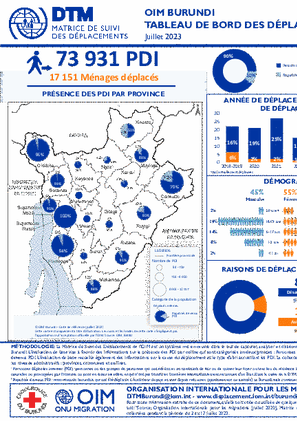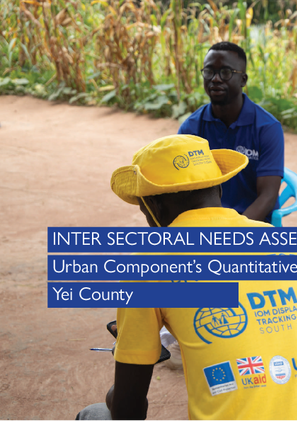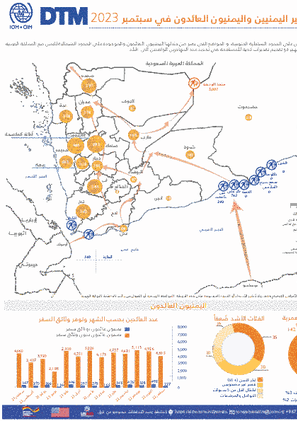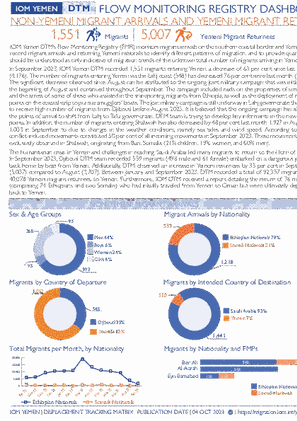-
Countries
-
Data and Analysis
-
Special Focus
-
Crisis Responses

Contact
DTMBurundi@iom.int
Language
English
Location
Burundi
Period Covered
Jul 02 2023
Jul 17 2023
Activity
- Flow Monitoring Survey
- Flow Monitoring
La Matrice de Suivi des Déplacements de l’OIM est un système mis en œuvre dans le but de capturer, analyser et disséminer des informations pour mieux comprendre les mouvements et les besoins des personnes déplacées internes (PDI) au Burundi. L'évaluation de base vise à fournir des informations sur la présence des PDI par colline qui sont catégorisés en deux groupes : Personnes déplacées internes (PDI) incluant les PDI retournées dans leur colline d'origine mais pas dans leur maison et les rapatriés devenus PDI. L'évaluation de base recueille également des informations sur la cause du déplacement et le type d'abri accueillant les PDI. La collecte des données est effectuée quatre fois par an par des volontaires formés de la Croix-Rouge du Burundi et opérant à tous les niveaux administratifs : provinces, communes et collines.

Contact
DTM Burundi, DTMBurundi@iom.int
Language
English
Location
Burundi
Period Covered
Jul 02 2023
Jul 17 2023
Activity
- Mobility Tracking
- Baseline Assessment
IOM’s Displacement Tracking Matrix is a comprehensive system to analyse and disseminate information to better understand the movements and needs of Internally Displaced Persons (IDPs) in Burundi. The baseline assessment aims at providing information on the stock (presence) by colline of IDPs which are categorized into two groups: Internally Displaced Persons (IDPs) including IDPs who returned to their colline of origin but not their home and returnees who became IDPs. The baseline assessment also collects information on the cause of displacement and the type of shelter hosting IDPs. Data collection is conducted four times per year by trained Burundian Red Cross volunteers operating at all administrative levels: provinces, communes and collines.

Contact
DTM South Sudan, SouthSudanDTM@iom.int
Language
English
Location
South Sudan
Period Covered
Sep 01 2022
Oct 31 2022
Activity
- Survey
- Return Intention
Between September and October 2022, the International Organization for Migration’s Displacement Tracking Matrix (IOM DTM) undertook its third household-level multi-sector assessment of selected urban areas and camps for internally displaced persons (IDPs) in South Sudan. The assessment aims to:
• Quantify the prevalence of vulnerabilities and humanitarian needs across sectors, with a focus on food security, economic vulnerability and nutrition as well as selected indicators on shelter and non-food items (SNFI), education, health, water, hygiene and sanitation (WASH), protection (including child protection and gender-based violence) and mental health and psycho-social support (MHPSS).
• Generate a better understanding of urban displacement and migration, including return and relocation after displacement in South Sudan or abroad.
There has been slow progress in the humanitarian situation in South Sudan. People’s humanitarian needs continue to rise, driven by cumulative and compounding effects of years of conflict, sub-national violence, food insecurity, climate crisis and public health challenges. Conflict and insecurity, fueled by sub-national and inter-communal violence, crime, and wide-scale impunity, continue to be among the main drivers of humanitarian needs in South Sudan.
Based on the request of the Humanitarian Country Team (HCT), mandated OCHA, IOM, and REACH to implement Inter-Sectoral Needs Assessment that aimed to understand demographics, multi-sectoral needs (including the level of severity) and barriers to assistance as well as displacement patterns and household-level scale.

Contact
DTM South Sudan, SouthSudanDTM@iom.int
Language
English
Location
South Sudan
Period Covered
Sep 01 2022
Oct 31 2023
Activity
- Survey
- Return Intention
Between September and October 2022, the International Organization for Migration’s Displacement Tracking Matrix (IOM DTM) undertook its third household-level multi-sector assessment of selected urban areas and camps for internally displaced persons (IDPs) in South Sudan. The assessment aims to:
• Quantify the prevalence of vulnerabilities and humanitarian needs across sectors, with a focus on food security, economic vulnerability and nutrition as well as selected indicators on shelter and non-food items (SNFI), education, health, water, hygiene and sanitation (WASH), protection (including child protection and gender-based violence) and mental health and psycho-social support (MHPSS).
• Generate a better understanding of urban displacement and migration, including return and relocation after displacement in South Sudan or abroad.
There has been slow progress in the humanitarian situation in South Sudan. People’s humanitarian needs continue to rise, driven by cumulative and compounding effects of years of conflict, sub-national violence, food insecurity, climate crisis and public health challenges. Conflict and insecurity, fueled by sub-national and inter-communal violence, crime, and wide-scale impunity, continue to be among the main drivers of humanitarian needs in South Sudan.
Based on the request of the Humanitarian Country Team (HCT), mandated OCHA, IOM, and REACH to implement Inter-Sectoral Needs Assessment that aimed to understand demographics, multi-sectoral needs (including the level of severity) and barriers to assistance as well as displacement patterns and household-level scale.

Contact
DTM South Sudan, SouthSudanDTM@iom.int
Language
English
Location
South Sudan
Period Covered
Sep 01 2022
Oct 31 2022
Activity
- Survey
- Return Intention
Between September and October 2022, the International Organization for Migration’s Displacement Tracking Matrix (IOM DTM) undertook its third household-level multi-sector assessment of selected urban areas and camps for internally displaced persons (IDPs) in South Sudan. The assessment aims to:
• Quantify the prevalence of vulnerabilities and humanitarian needs across sectors, with a focus on food security, economic vulnerability and nutrition as well as selected indicators on shelter and non-food items (SNFI), education, health, water, hygiene and sanitation (WASH), protection (including child protection and gender-based violence) and mental health and psycho-social support (MHPSS).
• Generate a better understanding of urban displacement and migration, including return and relocation after displacement in South Sudan or abroad.
There has been slow progress in the humanitarian situation in South Sudan. People’s humanitarian needs continue to rise, driven by cumulative and compounding effects of years of conflict, sub-national violence, food insecurity, climate crisis and public health challenges. Conflict and insecurity, fueled by sub-national and inter-communal violence, crime, and wide-scale impunity, continue to be among the main drivers of humanitarian needs in South Sudan.
Based on the request of the Humanitarian Country Team (HCT), mandated OCHA, IOM, and REACH to implement Inter-Sectoral Needs Assessment that aimed to understand demographics, multi-sectoral needs (including the level of severity) and barriers to assistance as well as displacement patterns and household-level scale.

Contact
DTM South Sudan, SouthSudanDTM@iom.int
Language
English
Location
South Sudan
Period Covered
Sep 01 2022
Oct 31 2022
Activity
- Survey
- Return Intention
Between September and October 2022, the International Organization for Migration’s Displacement Tracking Matrix (IOM DTM) undertook its third household-level multi-sector assessment of selected urban areas and camps for internally displaced persons (IDPs) in South Sudan. The assessment aims to:
• Quantify the prevalence of vulnerabilities and humanitarian needs across sectors, with a focus on food security, economic vulnerability and nutrition as well as selected indicators on shelter and non-food items (SNFI), education, health, water, hygiene and sanitation (WASH), protection (including child protection and gender-based violence) and mental health and psycho-social support (MHPSS).
• Generate a better understanding of urban displacement and migration, including return and relocation after displacement in South Sudan or abroad.
There has been slow progress in the humanitarian situation in South Sudan. People’s humanitarian needs continue to rise, driven by cumulative and compounding effects of years of conflict, sub-national violence, food insecurity, climate crisis and public health challenges. Conflict and insecurity, fueled by sub-national and inter-communal violence, crime, and wide-scale impunity, continue to be among the main drivers of humanitarian needs in South Sudan.
Based on the request of the Humanitarian Country Team (HCT), mandated OCHA, IOM, and REACH to implement Inter-Sectoral Needs Assessment that aimed to understand demographics, multi-sectoral needs (including the level of severity) and barriers to assistance as well as displacement patterns and household-level scale.
Contact
iomyemendtm@iom.int
Location
Yemen
Activity
- Flow Monitoring Survey
- Flow Monitoring
Period Covered
Sep 01 2023 -Sep 30 2023
In September 2023, IOM Yemen DTM recorded 1,551 migrants entering Yemen, a decrease of 63 per cent since last month (4,176). The number of migrants entering Yemen via the Lahj coast (548) has decreased 76 per cent since last month (2,249). The significant decrease observed since August can be attributed to the ongoing joint military campaign that was initiated at the beginning of August and continued throughout September. The campaign included raids on the properties of smugglers and the arrest of some of these who assisted in the transporting migrants from Ethiopia, as well as the deployment of military points on the coastal strip to pursue smugglers' boats. The join military campaign is still underway in Lahj governorate that used to receive high number of migrants from Djibouti before August 2023. It is believed that the ongoing campaign has affected the points of arrival to shift from Lahj to Ta'iz governorate. DTM team is trying to develop key informants in the new arrival points. In addition, the number of migrants entering Shabwah has also decreased by 48 per cent last month 1,927 in August to 1,003 in September to due to changes in the weather conditions, namely sea tides and wind speed. According to DTM, conflict-induced movements constituted 50 per cent of all incoming movements in September 2023. These movements were exclusively observed in Shabwah, originating from Bari, Somalia (21% children, 19% women, and 60% men).
The humanitarian crisis in Yemen and challenges in reaching Saudi Arabia led many migrants to return to the Horn of Africa. In September 2023, Djibouti DTM team recorded 559 migrants (498 male and 61 female) embarked on a dangerous journey back home by boat from Yemen. Additionally, DTM observed an increase in Yemeni returnees by 35 per cent in September (5,007) compared to August (3,707).
Between January and September 2023, DTM recorded a total of 92,357 migrants and 40,078 Yemeni migrant returnees to Yemen. Furthermore, IOM DTM received a report detailing the return of 76 migrants (comprising 74 Ethiopians and two Somalis) who had initially traveled from Yemen to Oman but were ultimately deported back to Yemen.
Population Groups
Survey Methodology
Unit of Analysis Or Observation
Type of Survey or Assessment
Keywords
Geographical Scope
Administrative boundaries with available data
The current dataset covers the following administrative boundaries

Contact
IOM DTM Yemen, iomyemendtm@iom.int
Language
English
Location
Yemen
Period Covered
Sep 01 2023
Sep 30 2023
Activity
- Flow Monitoring
في سبتمبر 2023، سجلت مصفوفة تتبع النزوح التابعة للمنظمة الدولية للهجرة في اليمن دخول 1,551 مهاجرًا إلى اليمن، بانخفاض قدره 63 بالمائة منذ الشهر الماضي (4,176). وانخفض عدد المهاجرين الذين يدخلون اليمن عبر ساحل لحج (548) بنسبة 76 في المائة منذ الشهر الماضي (2249). ويمكن أن يعزى الانخفاض الكبير الملحوظ منذ شهر أغسطس إلى الحملة العسكرية المشتركة المستمرة التي بدأت في بداية شهر أغسطس واستمرت طوال شهر سبتمبر. وتضمنت الحملة مداهمة ممتلكات المهربين واعتقال عدد منهم الذين ساعدوا في نقل المهاجرين من إثيوبيا، فضلاً عن نشر نقاط عسكرية على الشريط الساحلي لملاحقة قوارب المهربين. ولا تزال الحملة العسكرية المشتركة مستمرة في محافظة لحج التي كانت تستقبل أعداداً كبيرة من المهاجرين من جيبوتي قبل أغسطس 2023. ويعتقد أن الحملة المستمرة أثرت على نقاط الوصول للانتقال من لحج إلى محافظة تعز. يحاول فريق مصفوفة تتبع النزوح تطوير المخبرين الرئيسيين في نقاط الوصول الجديدة. بالإضافة إلى ذلك، انخفض أيضًا عدد المهاجرين الذين يدخلون شبوة بنسبة 48 بالمائة الشهر الماضي من 1,927 في أغسطس إلى 1,003 في سبتمبر، وذلك بسبب التغيرات في الظروف الجوية، وتحديداً المد البحري وسرعة الرياح. وفقًا لمصفوفة تتبع النزوح، شكلت الحركات الناجمة عن النزاع 50% من جميع الحركات الواردة في سبتمبر 2023. وقد لوحظت هذه الحركات حصريًا في شبوة، مصدرها باري بالصومال (21% أطفال، 19% نساء، و60% رجال).
أدت الأزمة الإنسانية في اليمن وتحديات الوصول إلى المملكة العربية السعودية إلى عودة العديد من المهاجرين إلى القرن الأفريقي. في سبتمبر 2023، سجل فريق مصفوفة تتبع النزوح في جيبوتي أن 559 مهاجرًا (498 ذكر و61 أنثى) انطلقوا في رحلة خطيرة للعودة إلى وطنهم بالقارب من اليمن. بالإضافة إلى ذلك، لاحظت مصفوفة تتبع النزوح زيادة في عدد العائدين اليمنيين (35%) في سبتمبر (5,007) مقارنة بشهر أغسطس (3,707). بين يناير وسبتمبر 2023، سجلت مصفوفة تتبع النزوح إجمالي 92,357 مهاجرًا و40,078 مهاجرًا يمنيًا عائدًا إلى اليمن. علاوة على ذلك، تلقت مصفوفة تتبع النزوح التابعة للمنظمة الدولية للهجرة تقريرا مفصلا عن عودة 76 مهاجرا (من بينهم 74 إثيوبيا وصوماليين اثنين) كانوا قد سافروا في البداية من اليمن إلى عمان ولكن تم ترحيلهم في النهاية إلى اليمن.

Contact
IOM DTM Yemen, iomyemendtm@iom.int
Language
English
Location
Yemen
Period Covered
Sep 01 2023
Sep 30 2023
Activity
- Flow Monitoring
In September 2023, IOM Yemen DTM recorded 1,551 migrants entering Yemen, a decrease of 63 per cent since last month (4,176). The number of migrants entering Yemen via the Lahj coast (548) has decreased 76 per cent since last month (2,249). The significant decrease observed since August can be attributed to the ongoing joint military campaign that was initiated at the beginning of August and continued throughout September.. The campaign included raids on the properties of smugglers and the arrest of some of these who assisted in the transporting migrants from Ethiopia, as well as the deployment of military points on the coastal strip to pursue smugglers' boats. The join military campaign is still underway in Lahj governorate that used to receive high number of migrants from Djibouti before August 2023. It is believed that the ongoing campaign has affected the points of arrival to shift from Lahj to Ta'iz governorate. DTM team is trying to develop key informants in the new arrival points. In addition, the number of migrants entering Shabwah has also decreased by 48 per cent last month 1,927 in August to 1,003 in September to due to changes in the weather conditions, namely sea tides and wind speed. According to DTM, conflict-induced movements constituted 50 per cent of all incoming movements in September 2023. These movements were exclusively observed in Shabwah, originating from Bari, Somalia (21% children, 19% women, and 60% men).
The humanitarian crisis in Yemen and challenges in reaching Saudi Arabia led many migrants to return to the Horn of Africa. In September 2023, Djibouti DTM team recorded 559 migrants (498 male and 61 female) embarked on a dangerous journey back home by boat from Yemen. Additionally, DTM observed an increase in Yemeni returnees by 35 per cent in September (5,007) compared to August (3,707). Between January and September 2023, DTM recorded a total of 92,357 migrants and 40,078 Yemeni migrant returnees to Yemen. Furthermore, IOM DTM received a report detailing the return of 76 migrants (comprising 74 Ethiopians and two Somalis) who had initially traveled from Yemen to Oman but were ultimately deported back to Yemen.
